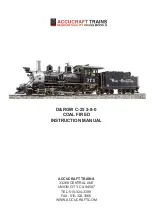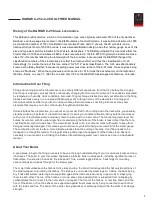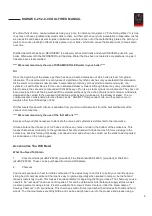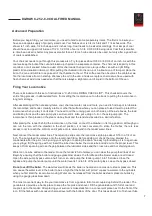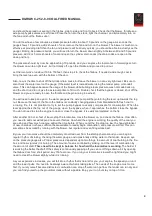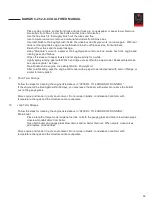
D&RGW C-25 2-8-0 COAL FIRED MANUAL
9
Ending Your Run
Unlike a butane locomotive, you cannot just turn the burner off to finish a run. When it approaches time to quit,
quit stoking, but keep the engine running as the combustion level drops. Adding water will also further cool the
boiler down. Let the locomotive finish cooling down to a temperature that allows handling without discomfort.
When the engine is cool enough to move around, hang the rear truck over the edge of a table and drop the
grates with the unburned coal , ash and occasional clinker. There should not be any hot embers remaining, but on
the off chance there are, it is best to hold an empty coffee can underneath the grate while you drop it. Shake the
grates and ash pan out and use the grate retaining pin to clear any small bits that may be stuck in the spaces of
the grates.
Before replacing the grates be sure to brush down the rear truck, and locomotive frame pieces that may be
littered with ash. Replace the grate, and brush the accumulation of ash off the locomotive and running gear. This
superficial brush down will suffice for a couple of hours between runs, but is not sufficient for overnight or longer
storage.
After Run Cleaning
When you are finished running your locomotive for the day, and will be returning it to storage, it will need a thor-
ough cleaning, and re-Iubrication. The extent to which you clean it will depend upon how long you have run it and
how long it will remain in storage.
AFTER EVERY RUN
•
Remove grate I ash pan
•
Place engine on table so that front truck and rear truck are on newspaper or paper towel.
•
Brush off rear truck and its swivel linkage.
•
Relubricate front and rear truck axles and swivel linkage. Use straight SAC - 40 weight oil.
•
Lightly spray running gear with WO-40 and wipe excess off with a paper towel to remove cinder, ash and
ballast dust
•
Relubricate entire running gear. Use straight SAE - 40 weight oil.
•
Replace grate/ash pan.
In situations where your running time has not exceeded 2 hours, and you will be running the locomotive again in
less than 24 hours, the above cleaning will suffice .
AFTER 3 TO 4 HOURS OF ACCUMULATED RUNNING TIME
•
Remove grate/ash pan
•
Place engine on table so that front truck and rear truck are on newspaper or paper towel.
Remove smoke box front. Unscrew two 1.6mm hex bolt on either sides of the smoke box.
•
Use the flue brush to thoroughly brush out the tubes and flue, only when completely cooled down.
•
Use computer vacuum to remove accumulated cinders from smoke box.
•
Use toothbrush to thoroughly brush inside of smoke box and its pipe work; vacuum again.
With rear truck overhanging table edge, use toothbrush to brush out the firebox sides, front and back.
Brush off rear truck and its swivel linkage.
•
Using “Stoddard” solvent in a sprayer, thoroughly wash out smoke box, smoke box front, engine, running
gear, and firebox.
•
Wipe off residue with paper towels and let engine air dry for a while .
•
Lightly spray running gear only, with WD-40 and wipe excess off with a paper towel.
•
Reassemble smoke box, replace grate/ash pan .
•
Re-lubricate entire engine. Use straight SAE - 40 weight oil.
•
After re-Iubricating, wipe the engine and tender with a paper towel dampened with Lemon Pledge, or
similar furniture polish.

